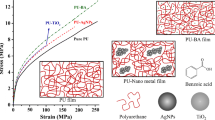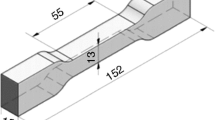Abstract
Nitric oxide (NO) delivery is an effective method for the development of NO-mediated therapy under the physiological conditions for biological applications. S-nitrosothiol is the most widely used NO donor for therapeutics which is capable of spontaneously releasing NO under physiological conditions and acts as a potential stable source of NO and as an S-nitrosating agent. In this present work, the preparation of a biodegradable and biocompatible polymer poly(acrylic acid) (PAA–CANO) cross linked with the S-nitrosothiol,cysteamine (CANO) is reported. Thus, prepared polymer showed a controlled maximum release of NO up to 6 days and it provided a potential defense against pathogenic bacteria. The prepared PAA–CANO was characterized by various techniques such as Fourier transform infrared spectroscopy, ultraviolet–visible spectrophotometry, nuclear magnetic resonance spectroscopy, and thermogravimetric analysis. In addition, loading of PAA–CANO into spongy scaffolds consisting of chitosan and alginate in 1:2 ratio resulting in a new antibacterial active compound suitable for providing infection-free environment on surgical covers, devices, and apparel is also reported. This polymeric scaffold showed a controlled NO release of 2.43 × 10−10 M/s/cm2. The morphology of the scaffolds is a micro-fibrous structure with a porosity of 57% and it was characterized by scanning electron microscopy.
Graphical abstract
Covalent tethering of nitric-oxide-releasing compound S-nitrosocysteamine to poly(acrylic acid) improves its stability and leads to controlled release of nitric oxide useful for the antibacterial activity.









Similar content being viewed by others
References
Ignarro LJ, Buga GM, Wood KS et al (1987) Endothelium-derived relaxing factor produced and released from artery and vein is nitric oxide. Proc Natl Acad Sci 84:9265–9269. doi:10.1073/pnas.84.24.9265
Carpenter AW, Schoenfisch MH (2012) Nitric oxide release: part II. Therapeutic applications. Chem Soc Rev 41:3742. doi:10.1039/c2cs15273h
Jen MC, Serrano MC, Van Lith R, Ameer Ga (2012) Polymer-based nitric oxide therapies: recent insights for biomedical applications. Adv Funct Mater 22:239–260. doi:10.1002/adfm.201101707
Wink Da, Kasprzak KS, Maragos CM et al (1991) DNA deaminating ability and genotoxicity of nitric oxide and its progenitors. Science 254:1001–1003. doi:10.1126/science.1948068
Hetrick EM, Schoenfisch MH (2006) Reducing implant-related infections: active release strategies. Chem Soc Rev 35:780–789. doi:10.1039/b515219b
Naghavi N, De Mel A, Alavijeh OS et al (2013) Nitric oxide donors for cardiovascular implant applications. Small 9:22–35. doi:10.1002/smll.201200458
Wang PG, Xian M, Tang X et al (2002) Nitric oxide donors: chemical activities and biological applications. Chem Rev 102:1091–1134. doi:10.1021/cr000040l
Hrabie Ja, Keefer LK (2002) Chemistry of the nitric oxide-releasing diazeniumdiolate “(nitrosohydroxylamine)” functional group and its oxygen-substituted derivatives. Chem Rev 102:1135–1154. doi:10.1021/cr000028t
Sortino S (2010) Light-controlled nitric oxide delivering molecular assemblies. Chem Soc Rev 39:2903–2913. doi:10.1039/b908663n
Duong HTT, Kamarudin ZM, Erlich RB et al (2013) Intracellular nitric oxide delivery from stable NO-polymeric nanoparticle carriers. Chem Commun (Camb) 49:4190–4192. doi:10.1039/c2cc37181b
Riccio DA, Schoenfisch MH, Riccio DA (2012) Nitric oxide release: part I. Macromolecular scaffolds. Chem Soc Rev. doi:10.1039/c2cs15272j
Chou HC, Chiu SJ, Liu YL, Hu TM (2014) Direct formation of S-nitroso silica nanoparticles from a single silica source. Langmuir 30:812–822. doi:10.1021/la4048215
Polizzi Ma, Stasko Na, Schoenfisch MH (2007) Water-soluble nitric oxide-releasing gold nanoparticles. Langmuir 23:4938–4943. doi:10.1021/la0633841
Rothrock AR, Donkers RL, Schoenfisch MH (2005) Synthesis of nitric oxide-releasing gold nanoparticles. Society 127:9362–9363. doi:10.1021/ja052027u
Stasko Na, Schoenfisch MH (2006) Dendrimers as a scaffold for nitric oxide release. J Am Chem Soc 128:8265–8271. doi:10.1021/ja060875z
Stasko Na, Fischer TH, Schoenfisch MH (2008) S-Nitrosothiol-modified dendrimers as nitric oxide delivery vehicles. Biomacromolecules 9:834–841. doi:10.1021/bm7011746
Lu Y, Sun B, Li C, Schoenfisch MH (2011) Structurally diverse nitric oxide-releasing poly(propylene imine) dendrimers. Chem Mater 23:4227–4233. doi:10.1021/cm201628z
Jae HS, Metzger SK, Schoenfisch MH (2007) Synthesis of nitric oxide-releasing silica nanoparticles. J Am Chem Soc 129:4612–4619. doi:10.1021/ja0674338
Shin JH, Schoenfisch MH (2008) Inorganic/organic hybrid sylica nanoparticles as a nitric oxide delivery scaffold. Chem Mater 20:239–249. doi:10.1021/cm702526q.Inorganic/Organic
Riccio Da, Nugent JL, Schoenfisch MH (2011) Stöber synthesis of nitric oxide-releasing S-nitrosothiol-modified silica particles. Chem Mater 23:1727–1735. doi:10.1021/cm102510q
Carpenter AW, Slomberg DL, Rao KS, Schoenfisch MH (2011) Influence of scaffold size on bactericidal activity of nitric oxide-releasing silica nanoparticles. ACS Nano 5:7235–7244. doi:10.1021/nn202054f
Carpenter AW, Worley BV, Slomberg DL, Schoenfisch MH (2012) Dual action antimicrobials: nitric oxide release from quaternary ammonium-functionalized silica nanoparticles. Biomacromolecules 13:3334–3342. doi:10.1021/bm301108x
Sun B, Slomberg DL, Chudasama SL et al (2012) Nitric oxide-releasing dendrimers as antibacterial agents. Biomacromolecules 13:3343–3354. doi:10.1021/bm301109c
Bing RJ, Yamamoto T, Kim H, Grubbs RH (2000) The pharmacology of a new nitric oxide donor: B-NOD. Biochem Biophys Res Commun 275:350–353. doi:10.1006/bbrc.2000.3304
Kim J, Saravanakumar G, Choi HW et al (2014) A platform for nitric oxide delivery. J Mater Chem B 2:341. doi:10.1039/c3tb21259a
Lutzke A, Pegalajar-Jurado A, Neufeld BH, Reynolds MM (2014) Nitric oxide-releasing S-nitrosated derivatives of chitin and chitosan for biomedical applications. J Mater Chem B 2:7449–7458. doi:10.1039/C4TB01340A
Damodaran VB, Joslin JM, Wold Ka et al (2012) S-nitrosated biodegradable polymers for biomedical applications: synthesis, characterization and impact of thiol structure on the physicochemical properties. J Mater Chem 22:5990. doi:10.1039/c2jm16554f
Damodaran VB, Reynolds MM (2011) Biodegradable S-nitrosothiol tethered multiblock polymer for nitric oxide delivery. J Mater Chem 21:5870. doi:10.1039/c1jm10315f
Priya S, Nithya R, Berchmans S (2014) S-nitrosothiol tethered polymer hexagons: synthesis, characterisation and antibacterial effect. J Mater Sci Mater Med 25:1–10. doi:10.1007/s10856-013-5032-0
Joslin JM, Lantvit SM, Reynolds MM (2013) Nitric oxide releasing tygon materials: studies in donor leaching and localized nitric oxide release at a polymer-buffer interface. ACS Appl Mater Interfaces 5:9285–9294. doi:10.1021/am402112y
Hetrick EM, Shin JH, Paul HS, Schoenfisch MH (2009) Anti-biofilm efficacy of nitric oxide-releasing silica nanoparticles. Biomaterials 30:2782–2789. doi:10.1016/j.biomaterials.2009.01.052
Suchyta DJ, Handa H, Meyerhoff ME (2014) A nitric oxide-releasing heparin conjugate for delivery of a combined antiplatelet/anticoagulant agent. Mol Pharm 11:645–650. doi:10.1021/mp400501c
Tiyaboonchai W (2003) Chitosan nanoparticles: a promising system for drug delivery. Naresuan Univ J 11:51–66
Samal SK, Dash M, Van Vlierberghe S et al (2012) Cationic polymers and theirtherapeutic potential. Chem Soc Rev. doi:10.1039/c2cs35094g
Khor E, Lim LY (2003) Implantable applications of chitin and chitosan. Biomaterials 24:2339–2349. doi:10.1016/S0142-9612(03)00026-7
Kayaman-Apohan N, Akdemir ZS (2005) Synthesis and characterization of pendant carboxylic acid functional poly(lactic acid) and poly(lactic acid-co-glycolic acid) and their drug release behaviors. Polym Adv Technol 16:807–812. doi:10.1002/pat.656
Coneski PN, Rao KS, Schoenfisch MH (2010) Degradable nitric oxide-releasing biomaterials via post-polymerization functionalization of cross-linked polyesters. Biomacromolecules 11:3208–3215. doi:10.1021/bm1006823
Morakinyo MK, Chipinda I, Hettick J et al (2012) Detailed mechanistic investigation into the S-nitrosation of cysteamine. Can J Chem 90:724–738. doi:10.1139/v2012-051
Roy B, Moulinet A, Fontecave M (2016) New thionitrites: synthesis, stability. J Org Chem 59(23):7019–7026
Grossi L, Montevecchi PC, Strazzari S (2001) Decomposition of S-nitrosothiols: unimolecular versus autocatalytic mechanism [1]. J Am Chem Soc 123:4853–4854. doi:10.1021/ja005761g
Fang FC (1997) Mechanisms of nitric oxide-related antimicrobial activity. J Clin Invest 99:2818–2825. doi:10.1172/JCI119473
Fang FC (2004) Antimicrobial reactive oxygen and nitrogen species: concepts and controversies. Nat Rev Microbiol 2:820–832. doi:10.1038/nrmicro1004
Chang WL, Peng KJ, Hu TM et al (2015) Nitric oxide-releasing S-nitrosothiol-modified silica/chitosan core-shell nanoparticles. Polymer (United Kingdom) 57:70–76. doi:10.1016/j.polymer.2014.12.020
Zeng M, Feng Z, Huang Y et al (2016) Chemical structure and remarkably enhanced mechanical properties of chitosan-graft-poly(acrylic acid)/polyacrylamide double-network hydrogels. Polym Bull. doi:10.1007/s00289-016-1697-0
Zhang XZ, Tian FJ, Hou YM, Ou ZH (2015) Preparation and in vitro in vivo characterization of polyelectrolyte alginate–chitosan complex based microspheres loaded with verapamil hydrochloride for improved oral drug delivery. J Incl Phenom Macrocycl Chem 81:429–440. doi:10.1007/s10847-014-0471-x
Hemalatha T, Yadav S, Krithiga G, Sastry TP (2016) Chitosan as a matrix for grafting methyl methacrylate: synthesis, characterization and evaluation of grafts for biomedical applications. Polym Bull 73:3105–3117. doi:10.1007/s00289-016-1644-0
Acknowledgements
The authors S. Sundari and Sheela Berchmans acknowledge the funding received from the CSIR 12th 5-year plan project Molecules To Materials To Devices (CSC0134) for carrying out this work. S. Umadevi would like to thank University Grants Commission (UGC)-Faculty Recharge Programme for financial support through Start-Up grant.
Author information
Authors and Affiliations
Corresponding author
Rights and permissions
About this article
Cite this article
Sundari, S., Berchmans, S. & Umadevi, S. Non-enzymatic nitric oxide release from biodegradable S-nitrosothiol bound polymer: synthesis, characterization, and antibacterial effect. Polym. Bull. 75, 2971–2985 (2018). https://doi.org/10.1007/s00289-017-2199-4
Received:
Revised:
Accepted:
Published:
Issue Date:
DOI: https://doi.org/10.1007/s00289-017-2199-4




